St Kilda

Dùn, and the disused radar station near the top of Mullach Sgar (photo by Gemma Smith, June 2017)
St Kilda is the rather fanciful name that has been accidentally acquired by a small volcanic archipelago in the North Atlantic, forty miles west of the Outer Hebrides. As anyone with a passing interest in the place will know already, there was no ‘Saint’ Kilda, although this does nothing to diminish the almost spiritual significance the islands seem to hold for so many of the people who visit, or the religious language they often use to describe it. I met a tourist in the Western Isles who had been on the day trip. ‘For miles and miles, there’s just nothing but water’, he told me, ‘and then it’s like someone’s plonked a ruddy great cathedral in the middle of the ocean.’ It has been suggested that the toponymic misunderstanding arose from the existence of a well in the village known as Tobar Childa in Gaelic – as tobar is ‘well’, the latter element was assumed to have come from the name of a saint. It in fact comes from the Old Norse kelda, which also means ‘well or spring’. Richard Coates’ 1990 book The place-names of St Kilda: nomina Hirtensia, dismisses this as a coincidence, and instead proposes that St Kilda comes from the Old Norse name Skildar, ‘shields’, which from its positioning on the early maps was actually more likely to apply to another island group much closer to the mainland of the Western Isles.
Either way, St Kilda is not what the Gaelic-speaking islanders would ever have called their home. They referred to it instead as Hiort, which has been anglicised – or rather latinised – as Hirta. As with many old names for which the original meaning has become obscure, numerous stories of varying degrees of plausibility attempt to ascribe a Gaelic etymology. Hiort is however more likely Old Norse in origin. The 12-13th-century Prests saga Guðmundar Arasonar tells of a ship from Iceland taking refuge ‘at the islands called Hirtir’ in 1202. The name hirtir, meaning ‘stags’, could potentially refer to the islands’ jagged, antler-like appearance from afar.
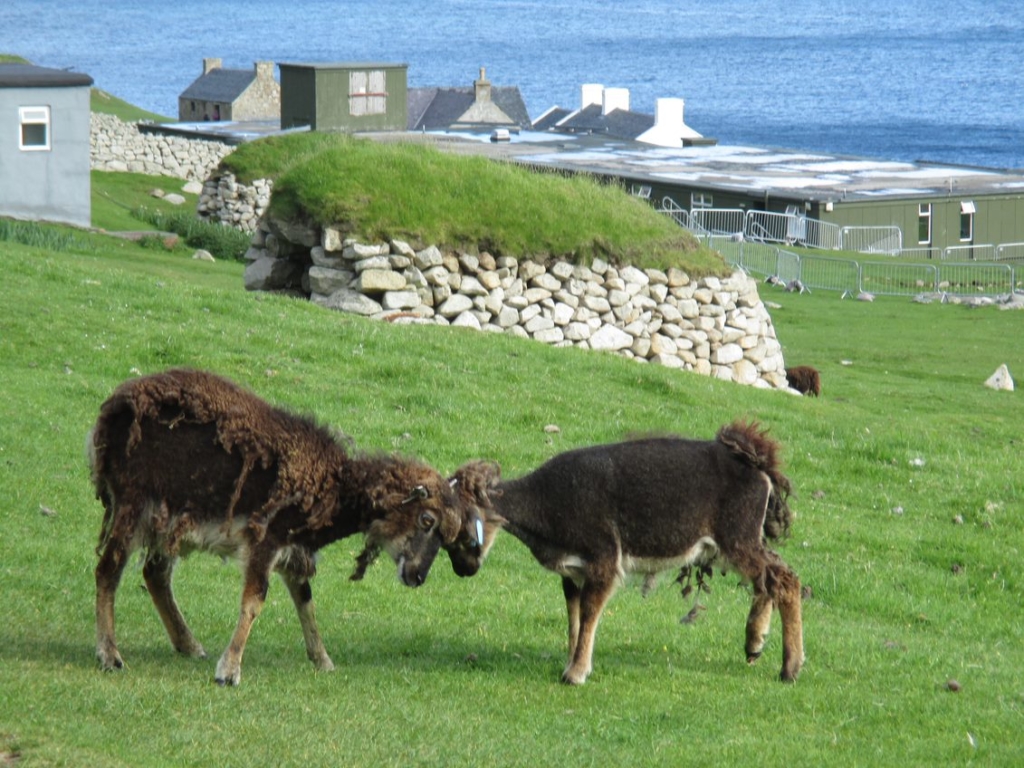
The Ablutions Block, the Feather Store, the old base, some cleitean, Soay sheep (photo by Gemma Smith, June 2017)
Norse settlement in St Kilda is attested by, among other things, its wildlife. The distinctive St Kilda mouse is more closely related to its Scandinavian cousins than to those of the British mainland. I was well familiar with the St Kilda mouse by the end of my second trip to the islands, as the cook for a National Trust Work Party. In the pre-Covid universe, the NTS used to assemble twelve random strangers to go out there for a fortnight at a time, staying in the renovated cottages and attending to basic conservation and maintenance tasks – kind of like an incredibly middle-class reality TV show for birdwatchers. Every morning at 7am before putting on the porridge I had to sweep the kitchen floor of protected St Kilda mouse droppings. At dusk – usually after 11pm on Hirta in early summer – the path outside would move with them, and we’d put out crumbs to try and entice them for a photo. In my experience, the St Kilda mouse is particularly fond of home-made flapjacks but almost impossible to get a decent picture of.
St Kilda illustrates the dynamism of place names and their meanings, and also the changing meanings of place itself. In contemporary times St Kilda has taken on an almost symbolic quality, becoming a kind of lieu de mémoire of displacement and loss; a monument to cianalas – a Gaelic word meaning a longing for place deeper than mere homesickness. Despite a wealth of recent scholarship dispelling many of the myths, popular depictions still emphasise its remoteness, the supposed harshness of its environment, and the supposedly archaic lifestyle of its previous inhabitants. The archipelago is often referred to as ‘the Islands at the Edge of the World’, after Michael Powell’s 1937 film The Edge of the World, about a depopulated island loosely based on Hirta. This appellation has been adopted by popular history books, heritage agencies, and travel writers, and has captured imaginations beyond the 5000 or so visitors who make it out to the archipelago every year. The idea of the islands as some kind of tragic Ultima Thule has spawned an entire mini-industry of dubious literature and moody photography. The mythology seems to be what people want. UNESCO’s own description of the Dual World Heritage Site does nothing to counter any misconceptions:
‘St Kilda is one of the toughest and most unforgiving places for human beings to live and thrive on the planet. The last community of 36 people were evacuated from this remote Scottish island in 1930 after 4,000 years of continuous human occupation. The breathtaking landscapes, towering sea cliffs wrapped in mist, and the haunting remains of cottages are now empty and exposed to the elements. With the Island now home to some one million rare and endangered sea birds, are you ready to sail to ‘the islands at the edge of the world’ for the experience of a lifetime?’
The construction of St Kilda as some kind of place apart predates the evacuation by decades. The early accounts of outsiders like John Sands’ Life in St Kilda of 1878 established the islands as a remote and Romantic destination, and Victorian steamers began trips to the islands from the 1880s. Many of the most commonly reproduced photos of the islanders from that era were taken by George Washington Wilson, a commercial photographer who knew exactly what the tourists wanted to see: tumbledown houses, barefoot children, and mud. It seems many visitors preferred the pictures to reality – according to George Heathcote in 1900, they treated the St Kildans like ‘wild animals in a zoo’. As Fraser Macdonald writes in his 2001 article ‘St Kilda and the Sublime’, for many tourists their ‘corporeal adventure into the Ossianic and oceanic sublime was disrupted by the islanders’ religion and social organization.’
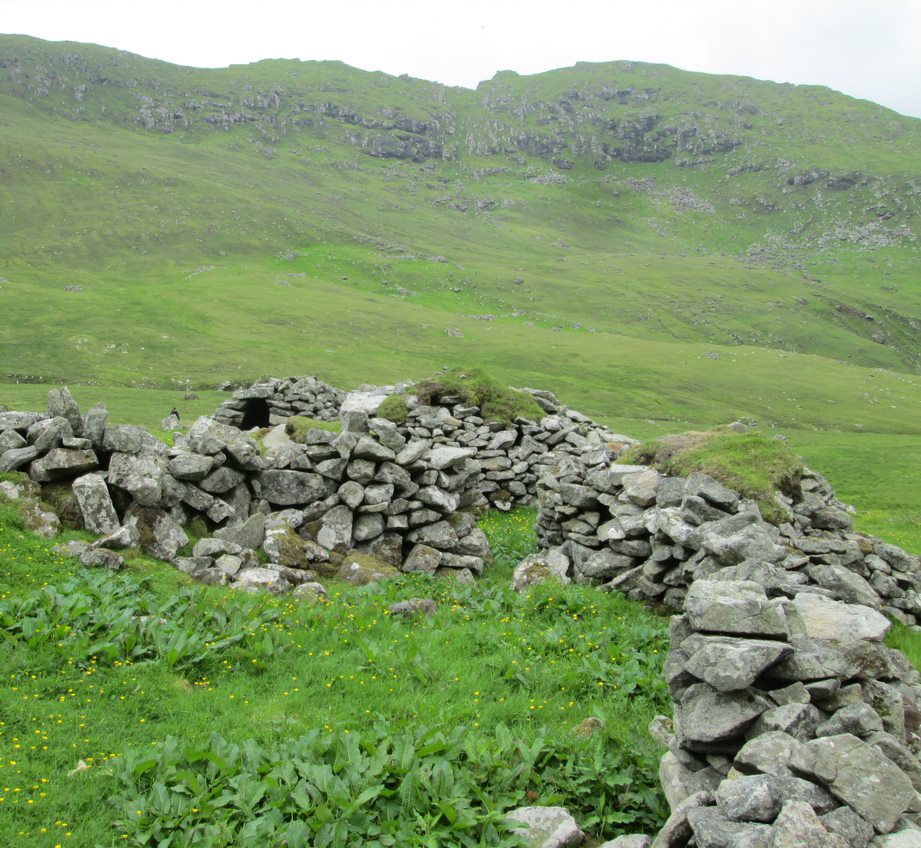
‘The Amazon’s House’ – or a shieling (photo by Gemma Smith, May 2014)
Despite the population of Hirta remaining resolutely Gaelic-speaking up to the evacuation, most of the place names best known to modern visitors are English, and were coined by outsiders over the last couple of centuries. The Amazon’s House, Calum Mòr’s House, the Lover’s Stone and Lady Grange’s House are all tenuously linked to genuine history and tradition but have evolved into myths of their own. The earliest account of life on the island is Martin Martin’s 1697 A Voyage to St. Kilda. A Gaelic-speaker from Skye, Martin tells us of what was presumably Taigh na Banaghaisgeich, ‘the warrior woman’s house’, and says the islanders have many stories about her. The building itself was an unusually large shieling hut, probably constructed out of the ruins of an older structure, and is referred to simply as Àirigh Mhòr, ‘great shieling’ on the first toponymic map made in 1928. Given that the shieling was a female-dominated domain, it is only fitting that tales of a warrior woman sprung from this place. ‘The Amazon’s House’ was the name that stuck, the specific lore behind the original has now been lost forever – although there are faint traces of a similar folkloric figure in Uist. A succession of gentleman-travelers, writers, anthropologists, curiosity-seekers, artists, and scientists followed in Martin’s wake, each seeking something different from this collection of rocks out in the Atlantic, something that depended as much on what the baggage they brought with them as on what they actually found there.
The first time I went, as a volunteer, I must admit I too was looking for something – like many urbanites my lifestyle made me crave isolation, and I just wanted to get away from people. I couldn’t have chosen a less suitable destination. If you are seeking solitude on Hirta, you at least need to get up and over the hill to the far side of the island before 11am to avoid the day-trippers. There are new boats in the bay every morning, helicopters coming in and out to the military base, and a diverse assortment of MoD employees, researchers, artists, and volunteers kicking about the island at any given time. I soon identified the best spots in which to hide from the madding crowds, often going for a walk up what we called the ‘dark end of the village’ after dinner, or on to Ruaival (Old Norse rauðafjall, ‘red hill’), a small hill on the west side of the island towards that jagged row of stony teeth called Dùn (Gaelic for ‘fort’), and a superb place from which to watch the setting sun. From Ruaival you can enjoy one of my favorite views in Scotland, a view of almost nothing at all – nothing but the sky and the endless, shimmering, blue silk of the Atlantic stretched out between here and Newfoundland.

The North Atlantic, from Ruaival (photo by Gemma Smith, May 2014)
Kevin Grant was the NTS archeologist on Hirta during my first visit. Working there for three years, his resulting PhD thesis ‘Mo Rùn am Fearann’ – ‘My Love is the Land’: Gaelic Landscapes of the 18th and 19th Centuries focuses on the communities of St Kilda and South Uist. Concentrating on the archaeology and Gaelic sources such as poetry and song, Grant paints a much fuller and more nuanced picture of life in St Kilda that neither exoticises nor Romanticises the place, and puts its people at the heart of the story. The narratives he embeds in his thesis vividly evoke the excitement and celebration of community events like fowling expeditions, disputing previous depictions of folk miserably ekeing out their existences on the rock. As Grant said in an interview about his time on the island:
‘The story of St Kilda is the story of the rest of the Hebrides, and its archaeology plays that out. From the very first evidence on St Kilda we see we see people exactly as everyone else did… and it being a place that is very connected and culturally continuous with the Western Isles. So we see on St Kilda what happened everywhere else – a culture of crofting has been replaced with a culture of tourism and Ministry of Defence work. So in that sense the biography of St Kilda is exactly that of the Uists or Barra or Harris.’

In the evening light feannagan or ‘lazy-beds’ become visible on the steep slopes of Dùn (photo by Gemma Smith, June 2017)
It was a personal connection rather than a quest for the remote that drew me back for a second time. After the passing of our chef, the inspirational Ann Prior, I felt an urge to step into her shoes and cook up a tribute to her memory. By that point, I had decidedly seen behind the curtain. I knew by then that St Kilda was far from uninhabited, that the structures were painstakingly maintained in a state of perfect ruination, and that the sheep were put there as a scientific experiment in the 1930s. It probably helped that our outward journey was the only sailing I attempted unmedicated – I spent the whole journey throwing up and then went straight for a lie down in a darkened room, which certainly took away from the drama of arrival. On the upside, it got me out of unloading two weeks’ food supplies from the boat and having to cart them uphill to the kitchen.
During that second visit we were joined by the researcher Lauren Collee, who subsequently wrote a profoundly perceptive account of her impressions of the islands. Entitled ‘A deeply weird place’: Fragile stories and disobedient bodies on the St Kilda archipelago, Collee’s 2017 thesis describes how St Kilda has variously been constructed as a wilderness, as a laboratory, and as a museum. The separation of ‘nature’ and ‘culture’ implicit in these narratives is disrupted by the unpredictable and disobedient bodies of seabirds, in the close encounters with wildlife that often characterise the visitor experience.
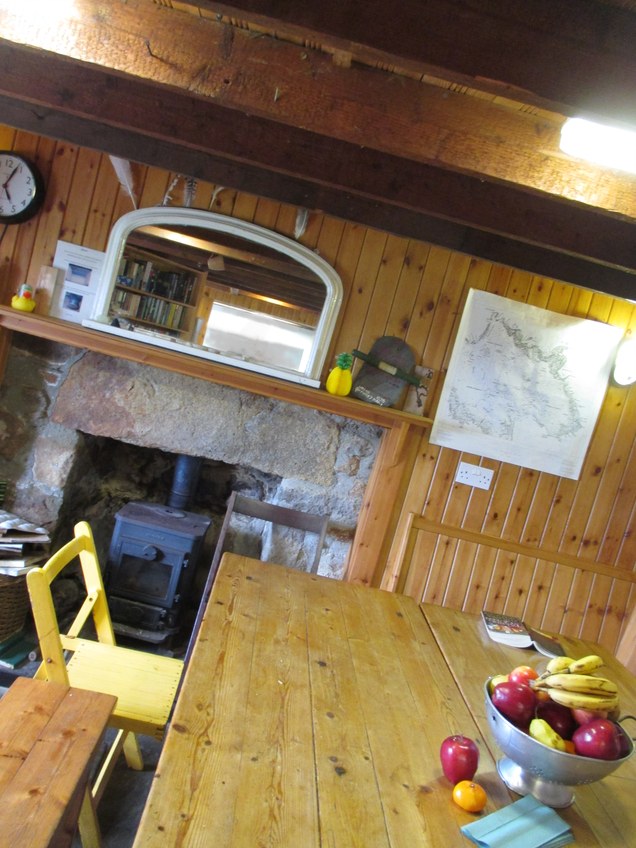
The dining room in House 1 (photo by Gemma Smith, June 2017)
You quickly realise on Hirta that you have effectively entered Birdland. As the boat approaches the island the air grows thick with gannets. The workshop keeps a store of ‘bonxie poles’: lengths of garden cane with a flag at one end, that you stick down the back of your rucksack to stop dive-bombing Great Skuas from reaching your head. Work Party lore tells of the volunteer who lost the hearing in one ear after being hit full force by an attacking bonxie’s feet. The fulmars dominate the village; sitting atop blackhouse ruins gossiping as you pass, lurking in the corners of unexplored cleitean waiting to surprise careless humans with a lob of noxious bile. On a stormy day you can watch them suspended in the air above the bay, surfing the wind for fun. One evening after putting the dinner on, I ran up the back of the houses for a few minutes’ peace. Finding an unusually sheep-shit-free patch of ground, I lay on the grass and closed my eyes, only to feel a sudden whoosh of air rush from my feet up the length of my body – it was a nosey fulmar performing a fly-over just a couple of inches above me. I moved back inside after the bird returned for the third time, fearing for my eyeballs.
On another unforgettable afternoon, three of us headed for the Dùn Gap – Caolas an Duin in Gaelic, referring to the strait between Hirta and its closest neighbour – and scrambled down the rocks to the water’s edge to get closer to the seals below. They were equally curious about us, and put on quite a show: flipping and twirling about in the water seemingly in formation, then singing, their voices echoing around the gap in an otherworldly chorus. We sat there for an hour completely mesmerised, before reluctantly heading back to the house for tea.
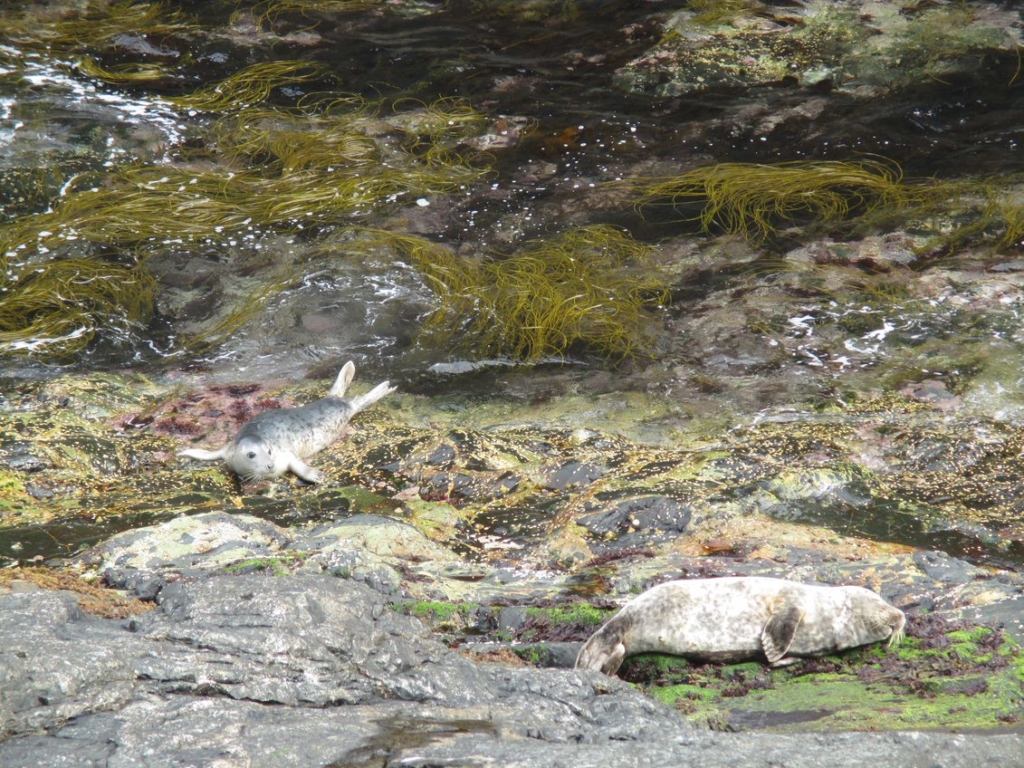
Some wee selkies at the Dùn Gap (photo by Gemma Smith, June 2017)
During that fortnight I became more interested in other visitors’ various motivations for getting there. I was surprised by how many day-trippers were older Scottish couples, often from the Western Isles, fulfilling a lifelong ambition. One afternoon I got chatting to one such lady sat down on the bench outside the cottage. I asked if she was enjoying her day. ‘Oh yes’, she said as she looked wistfully across the bay, then turned her gaze back towards the base. ‘It’s a shame about all this though, isn’t it?’, she said, gesturing towards the low, dark green-painted 1970s buildings, ‘it kind of ruins the atmosphere.’ I didn’t ask what kind of atmosphere she was looking for, but I’d guess it must have been something like melancholy. It put me in mind of a practice in bereavement therapy, where you take an object representative of your loss, put it in a box, and hide it away at the top of a cupboard in the furthest away corner of the house, taking it out again only when you are ready to grieve. Perhaps in that sense for some of its visitors St Kilda is less about what they find there, and more about what they leave behind.
Some of my Work Party-mates had traveled the world with the Merchant Navy; some had cycled across continents; others had lived in the Falkland Islands or sailed to South Georgia and Antarctica. One had worked as a doctor on Tristan da Cunha, another volcanic Atlantic island that lies almost 2000 miles off the coast of the African mainland. Compared with almost any other island, a place that sea-kayakers have got to in a day in favorable conditions hardly seems remote. It is with Tristan da Cunha that Coates compares St Kilda in his 1990 book. In the preface he says, ‘Tristan also once had an economy partly based on bird-products, and may have been the ‘nearest thing’ to St Kilda to survive to our own times. The inhabitants now watch Dallas with relish on cable TV.’ There wasn’t much that was unique about St Kilda, or inevitable about its fate.
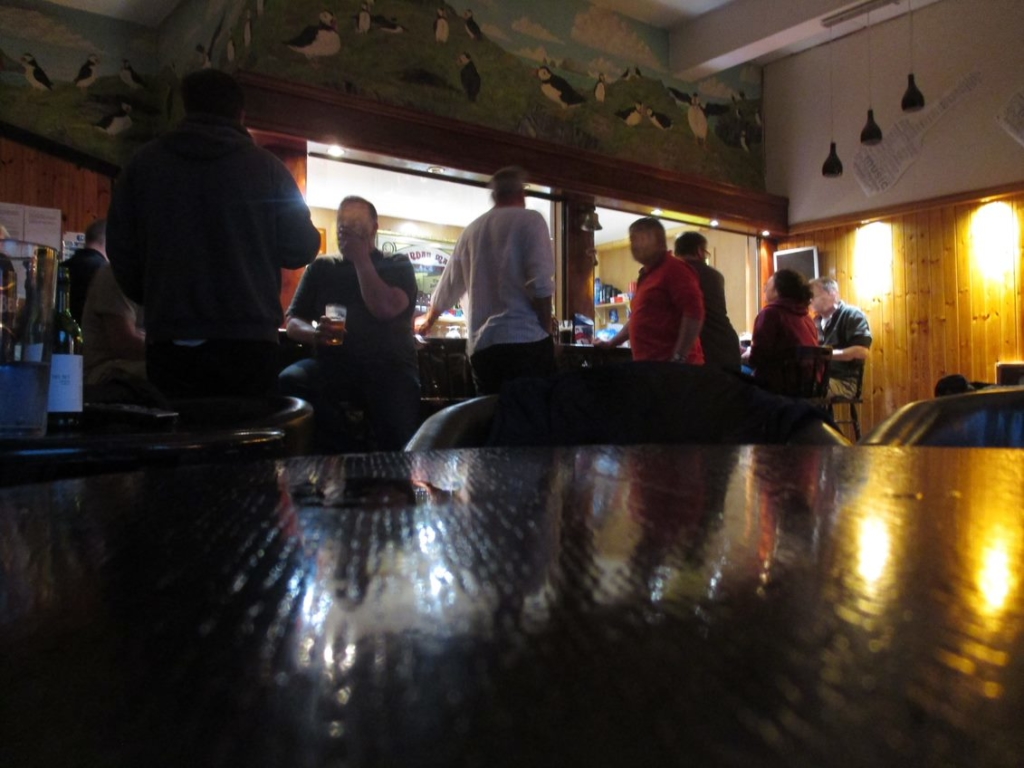
The now-defunct Puff Inn – one of the great bars of the world (photo by Gemma Smith, June 2017)
In St Kilda we can see that the meanings of place-names and the meaning of places themselves are unfixed, and open to continuous re-interpretation. By peeling back the layers of the toponymic landscape, we can look past our modern constructions to see such places through the eyes of the people to whom they were simply home, and a thoroughly domestic space. In their experience, as mine, this was far from an inhospitable environment. St Kilda is one of my favourite places on earth, and I think of it often. I expect many of the NTS and QinetiQ staff who return year on year feel the same. I can only imagine what it must have been like for the evacuees to leave it all behind; for that home to become all-but inaccessible to them forever. For those of us who have been lucky enough to get to know and love the place, St Kilda is never remote – we carry it with us everywhere. The name itself has traveled with us: suburbs, streets and houses across the globe are named in its remembrance. When you love somewhere it becomes part of you; not the edge of your world, but the centre. Remote is a relative term – nowhere is inherently remote. Us city folk tend to call places ‘remote’ when they represent what we have become distant from in our urban lives. When we describe somewhere as ‘remote’, often what we are really talking about is ourselves.

Help to support independent Scottish journalism by subscribing or donating today.

One of your most artistic sketches, Michael. I sent it to one of my most artistic friends, so it would/will be fully appreciated. Thank you.
Not by me – by Gemma
Enlightening and enjoyable. I have often wondered about visiting but probably never will.
The life of those that were evacuated is something we will never experience; we imagined it to be almost entirely isolated but maybe it was as described like inhabitants of a zoo.
Long ago I really enjoyed a holiday in Rural Skye. I will try to spend some time in the more remote areas of the Western Isles and that will probably suffice.
Thank you for this most interesting piece ….the photography added so well to the overall well written article.
Lovely to be taken into the islands in such a romantic unromantic way.
Very enjoyable, thanks! It reminded me there’s also some lovely essays about St Kilda (other islands available too) in Kathleen Jamie’s SIGHTLINES
What have we learned from our relationship with all that is “remote”? Nothing. Once “remote”, vibrant, indigenous Highland and Island communities continue to be depopulated by the cheque book, to be replaced by rootless, transient seekers of meaning, stability and permanence. The average “seeker” lasts two northern Winters, then hops to another lifestyle experiment. And what of the native individual or family? Who cares?
Twenty-odd years ago, I was summoned to a head office in London to form part of an NGO’s ‘Remote and Rural task-force’ alongside colleagues from other remote and rural areas of the country. Our remit was to investigate ways in which our organisation could better support our activities in those areas. The main recommendation that emerged from our investigation was that the organisation should stop treating our communities as ‘remote’. As far as we were concerned, we weren’t ‘remote’; the sticks we were out in were the centre of our respective worlds; from our point of view, if anywhere was ‘remote’, it was the urban centres of policy- and decision-making to which we had been problematically summoned.
The ‘remoteness’ of places like St Kilda speaks volumes of the value that we place on them as spiritual ‘retreats’. I can’t think of anyone who lives and works out here in ‘the sticks’ who shapes the land remotely as a ‘retreat’.
Valuing such places as ‘remote’ is its own form of exploitation.
Hi, I worked on St Kilda for many years as QinetiQ staff and would just like to point out the radar site at Mullach Sgar is, and always has been, in use for MOD purposes along with the main site at Mullach Mhor.
Nice bit of writing there Gemma, you transported me there whilst reading your story.
It’s a place dear to my heart, and hope to return to soon.
All the best.
Dave! So nice to hear from you. Delighted to transport you, however briefly. I hope you get a chance to go back and be an awesome Work Party Leader again soon 🙂
The traditions about the bana-ghaisgeach are not entirely lost. This is a snippet that was printed in a periodical in 1875 about St Kilda traditions which does, indeed, connect to Uist. It is very interesting that there seems to be a recollection of a lower sea level:
‘Besides being a people of prodigious strength, the St Kildans were in those days of an immense size – real Anakites. One of these – a female – governed St Kilda many ages ago. This huge daughter “of the giants” had, it seems, a great liking for sport, and always kept a pack of select hounds. At that time, says tradition, a vast tract of lowland extended from St Kilda to the mainland of Uist, from which it was separated by a very small stream at high water. […] When those sixty or eighty miles of sea lying between Uist and St Kilda were dry land, the female above referred to used to send her dogs to the hunt in Uist, while she herself stood upon one of the highest peaks of her lonely kingdom and directed them, both by voice and sign!’
Thanks Michael, I’d never come across that before – I only knew of the ref in Erskine Beveridge’s ‘North Uist’. What publication is it from? So frustrating that Martin Martin says there’s many stories of the Warrior Woman, but then neglects to record any!
P.S. Nice piece about the Amazon’s House by Hanna Tuulikki here btw:
https://hannatuulikkdiary.tumblr.com/post/61493010753/the-female-warrior-of-st-kilda
Thanks for a thoughtful and evocative piece, reminding me of my own visit as part of a NTS work party in 1987, helping with an archaeological excavation of one of the houses while sleeping in another. There were no day trippers to intrude then; we could roam as we liked and then enjoy a congenial evening or two in the Puff Inn.
I spent years working there nice to see the photos but your mistakenly saying that the radars are defunct
Great stuff. Thanks.